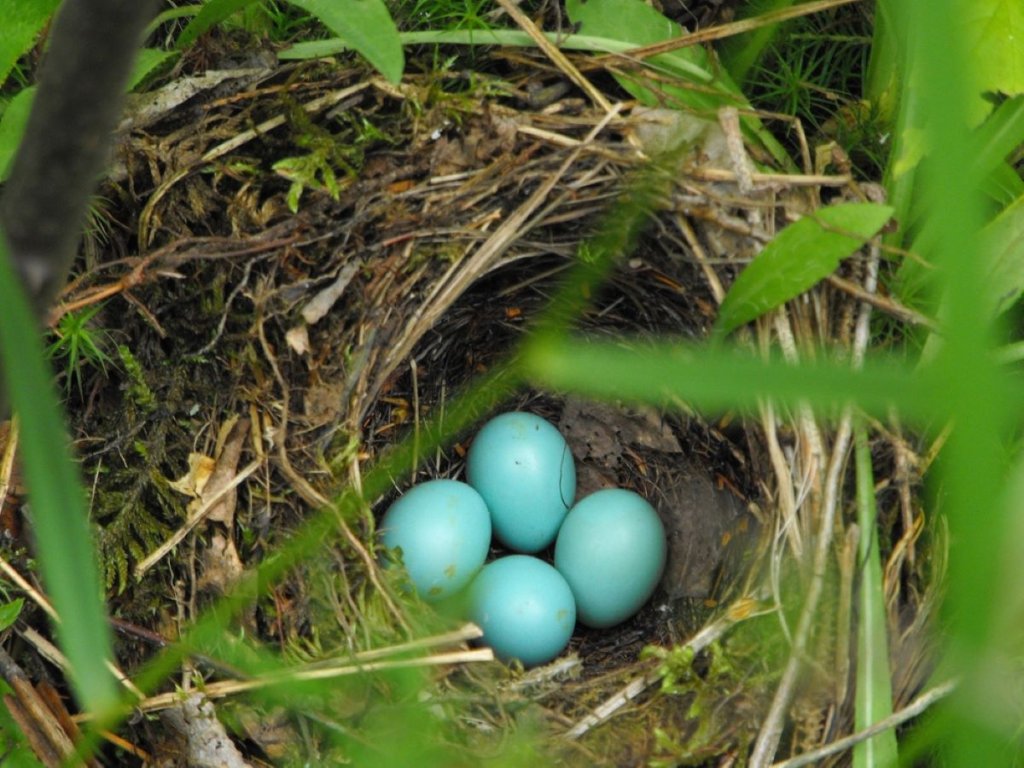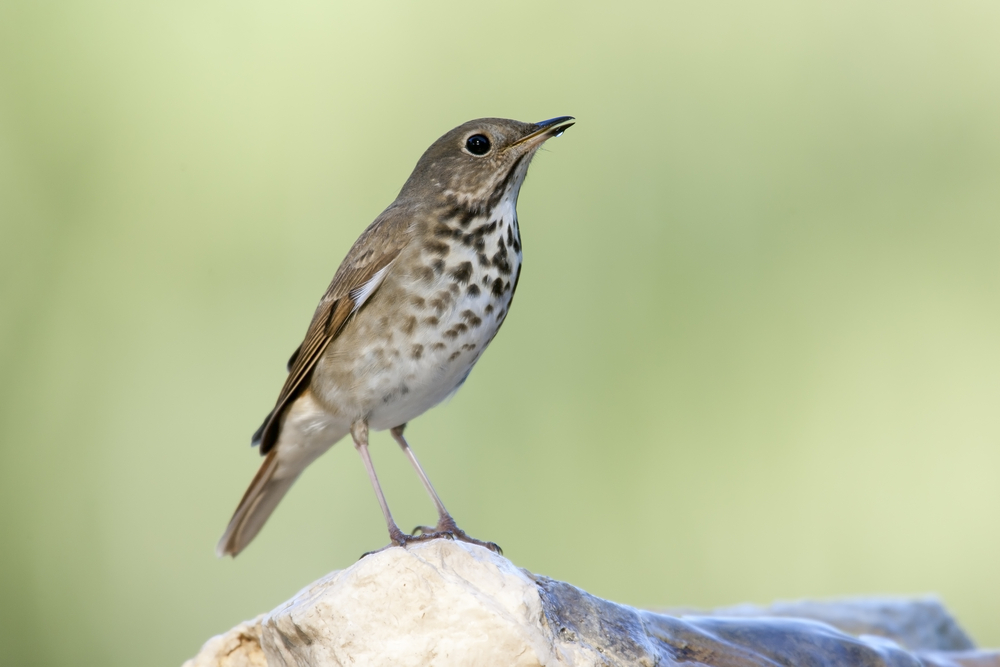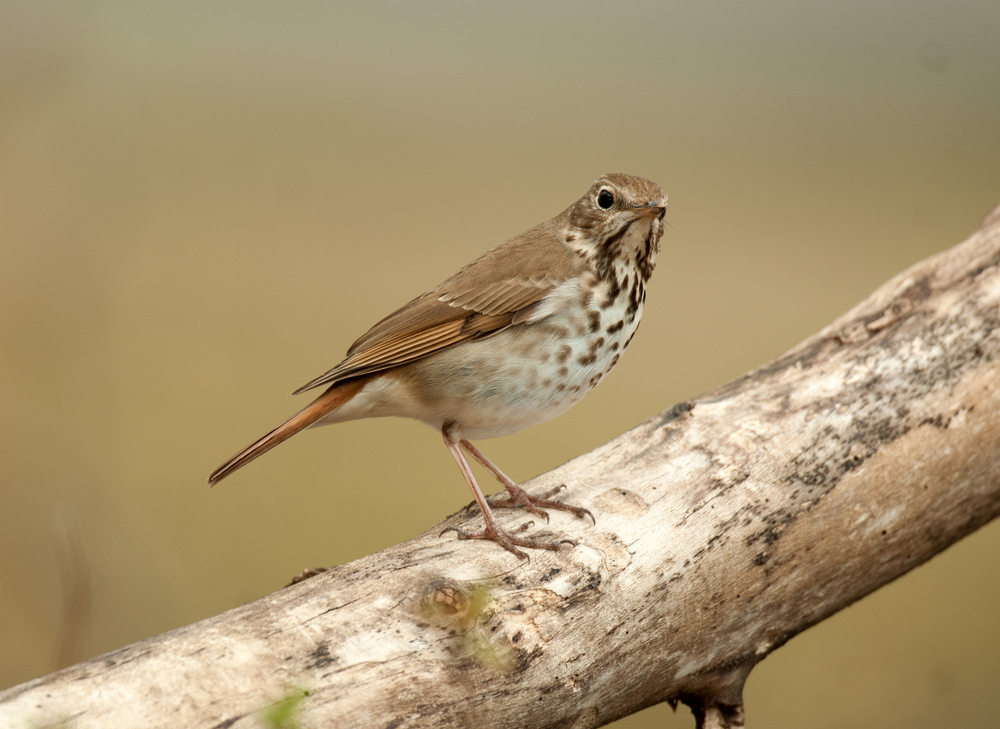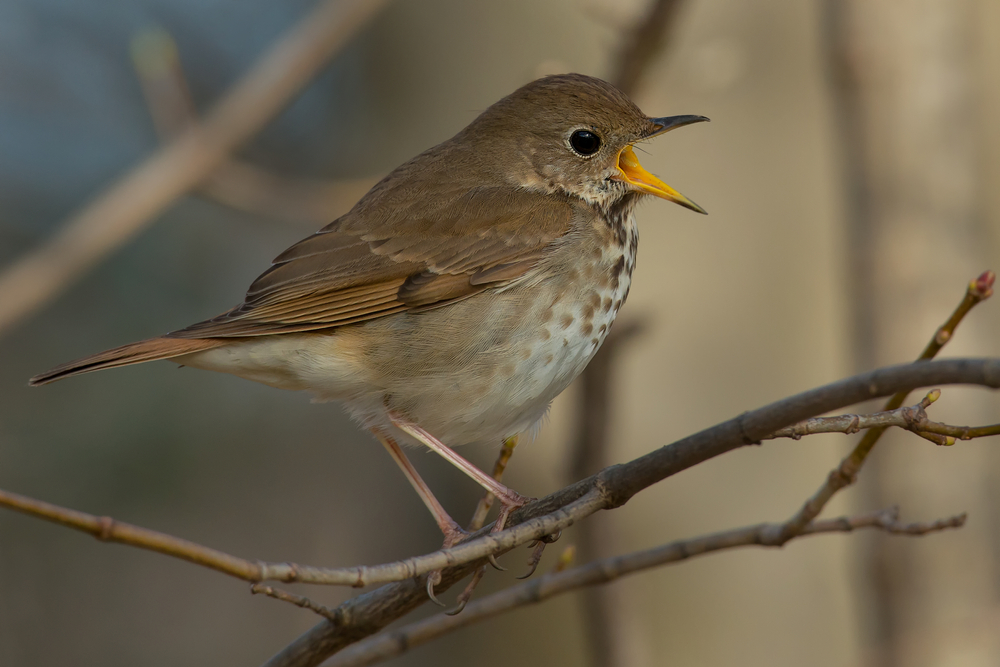The Hermit Thrush, or Catharus guttatus, earns its name by its reclusive and secretive nature. It is a part of the Turdidae family and is similar to the Bluebird and the American Robin. It’s not a bird that frequents backyard birdfeeders and makes its home in the lush protection of conifer and deciduous forests.
Hermit Thrushes, like any true hermit, are often heard but rarely seen. They have a flute-like song that is mournful and sad, albeit quite loud, and can be heard throughout the breeding season.
Hermit Thrushes are secretive, elusive birds that don’t like to make their presence known. Knowing exactly where to look is critical if you want to catch a glimpse of this painfully shy songbird.
Hermit Thrush Songbird Identification
Hermit Thrushes look similar to their cousin, the Wood Thrush, but their coloring isn’t as striking. Unlike the Wood Thrush, which boasts bright black spots, the spotting on the underparts of the Hermit Thrush is muted. They have an overall brown coloring, reddish tail, and subtle flecks of yellow in their upper parts.
The white rings around their eyes make their black eyes pop and make it easy for birdwatchers to spot. The Hermit Thrush doesn’t have many distinguishing features, but the spotted breast and white eye rings are a clear giveaway. While it looks similar to a Veery or Wood Thrush, the white eye rings are unique only to the Hermit Thrush.
Unlike other bird species, the male and female Hermit Thrush look almost identical. It’s also important to note that eastern and western Hermit Thrushes vary slightly in color. Eastern Hermit Thrushes have an olive-brown coloring, while their western counterparts are grayer.
Habitat and Diet
The Hermit Thrush prefers the dense protection of thick conifer and deciduous in cooler climates such as Alaska, Canada, and most parts of British Columbia. The Hermit Thrush isn’t a very social bird during the breeding season. It spends much of its time well away from residential areas and prefers the lush protection of thick forests.
Sometimes, you may spot a Hermit Thrush at the edge of a public park, but it’s rare. The non-breeding season is the best time to spot a Hermit Thrush. While they won’t dine in backyard feeders, they are commonly found in residential areas, gardens, and public parks.
In the summer, these reclusive Passeriformes dine primarily on insects. As ground-dwelling birds, they rummage through leaf litter in search of a juicy caterpillar or mealworm.
They mostly stick to berries such as mistletoe, grapes, elderberries, and pokeberries in their wintering grounds. Since they don’t eat at birdfeeders, the best way to attract these songbirds to your yard is by planting the fruit-bearing bushes they love most!

Mating, Nesting, and Eggs
What’s interesting about the Hermit Thrush is that their nesting location varies depending upon where they live. The nests of these songbirds residing in the west look very different from those in the east. Western Hermit Thrushes, for instance, build their nests in the branches of a tree high off the ground. On the east coast, however, where forests aren’t as plentiful, some make their nests at ground level near thickets with plenty of bushy protection from predators.
The female Hermit Thrush builds the nest alone. Their nests are slightly bulky and not as tightly woven as other songbirds. Each nest utilizes an open cup from plant materials such as weeds, sticks, and tree bark lined with rootlets and pine needles.
On average, the female lays four eggs per clutch. Her eggs are pale blue with subtle flecks of black or brown. Most Hermit Thrushes raise one to two broods per mating season, although birds living in the southern states sometimes raise three.
Geography and Range of Migration
Are you looking to catch a glimpse of the Hermit Thrush? You’re in luck! Their range map spans most of North America and some parts of Mexico and Central America. You may not be in their breeding range or wintering grounds, but you are likely in their migration path.
During the breeding season, the Hermit Thrush heads far north to places such as Alaska, Canada, New York, New England, and much of the Rocky Mountains. After breeding season, these migrants head as far south as Mexico. However, not all Hermit Thrushes make the long trip.
Some birds spend their wintering grounds in parts of the Midwest and southern states. No matter where you actually live in North America, there’s a good chance you can find these North American songbirds either in their breeding grounds, wintering grounds, or migration path.

Vocal Repertoire: Songs, Calls, and Sounds
The mating call of the Hermit Thrush is warbling, flute-like, and a little sad. It’s heard most frequently during the mating season and accompanies a faint whisper song that is only heard early in the springtime. While their song is a tell-tale sign that spring has sprung, their contact call is what birdwatchers hear the most.
Their contact calls are how coupled pairs communicate with each other and are used to communicate with their young. They have a very low-pitched ‘tchup’ noise when they spot a predator and a high-pitched ‘eeee’ when fleeing.

Why Are They Called Hermit Thrushes?
Their name isn’t just a coincidence. The Hermit Thrush earned its name from its secretive and reclusive nature. These birds aren’t frequent guests to backyard birdfeeders like other subspecies of Thrushes. They prefer to live, like a hermit, deep in conifer and deciduous forests far from human interaction.
While they will sometimes visit backyard spaces during the non-breeding season, it’s rare. If you want to draw the attention of Hermit Thrushes to your yard this winter, opting for birdfeeders won’t cut it. Planting fruit-bearing bushes, such as mistletoe, elderberries, and pokeberries, are a surefire way to draw the attention of these very shy songbirds.

